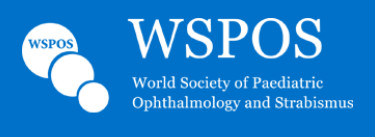Education
Case Report: Case 3
Case Presenters
Not currently available…
Status: CASE CLOSED
Members’ Responses:
When asked ‘How they would compensate for the function deficit of a traumatically detached left inferior rectus muscle that cannot be found’ 42.11% replied saying they would perform an Inferior Transposition (Total / Half) of both left horizontal rectus muscles, 15.79% said they would opt for Weakening of left superior rectus muscle, 10.53% preferred Weakening of right inferior rectus muscle, while 31.58% would perform an Anterior transposition of the left inferior oblique muscle, as was done here.
63.16% of our members would have carried out a surgery(s), despite not obtaining a good quality MRI, while 36.84% would refrain from performing a surgery without being able to obtain a good quality MRI.
Experts Opinion
In addition to answering the questions posed to our members, our Experts were also asked ‘How they would Explain the below mentioned Phenomenon : After Transposition of the Inferior Oblique Eye Muscle, an Improvement was observed in Left Eye Inferior Gaze, while bearing in mind the fact that the Inferior Oblique Eye Muscle is Relaxed in Infraversion’
Simon Ko

Dr. Simon Ko is a specialist in pediatric ophthalmology, strabismus and general ophthalmology. He is the chief of service of the Ophthalmology Department at Pamela Youde Nethersole Hospital and Tung Wah Eastern Hospital in Hong Kong. Dr. Ko has been working in ophthalmology for 25 years, and he is actively involved in clinical research, teaching, training and examination of ophthalmology in Hong Kong. He is an author and co-author of publications in peer-reviewed journals. Dr. Ko is currently serving on the council of the College of Ophthalmologists of Hong Kong and is past president of the Hong Kong Ophthalmological Association. Dr. Ko has also served in the Scientific Bureau of the World Society of Pediatric Ophthalmology and Strabismus. He received a Distinguished Service Award from the Asia-Pacific Academy of Ophthalmology in 2016 for his active contributions in meetings.
Dr. Simon Ko would choose Inferior Transposition (Total / Half) of both left horizontal rectus muscles in order to improve the infraduction across the lower field and improve primary position alignment. The chance of anterior segment ischaemia in this young gentleman is relatively small. I would have carried out a surgery(s), despite not obtaining a good quality MRI, if I had no other alternative & would still go ahead. In response to ‘How he would Explain the below mentioned Phenomenon : After Transposition of the Inferior Oblique Eye Muscle, an Improvement was observed in Left Eye Inferior Gaze, while bearing in mind the fact that the Inferior Oblique Eye Muscle is Relaxed in Infraversion’ Dr. Ko replied ‘After Transposition of the Inferior Oblique Eye Muscle, an Improvement was observed in Left Eye Inferior Gaze, while bearing in mind the fact that the Inferior Oblique Eye Muscle is relaxed in Infraversion. After the IO transposition surgery, the SO is acting against a weakened IO in primary and adduction, the depressor effect of SO results in an improved infraduction and primary. In abduction, the improvement in depression is not seen. The antielevation effect of anterior transposition surgery has helped to keep the eye in a more aligned position in primary gaze and facilitate the depressor action of the SO’.
Alcina Toscano

Dr. Alcina Toscano graduated in Medicine from Faculdade de Medicina de Coimbra in 1984. She completed her Ophthalmology training in 1992, at Centro Hospitalar de Lisboa Central, Lisbon. Since
1999 she is the Paediatric Ophthalmology Head Department at Centro Hospitalar de Lisboa Central.
She is a Pediatric Ophthalmology Consultant at Hospital Cuf Descobertas, Lisbon, since 2002. Her clinical expertise includes the evaluation and treatment of amblyopia, pediatric and adult strabismus and pediatric cataracts.
Dr. Alcina Toscano would use Inferior Transposition (Total / Half) of both left horizontal rectus muscles in order to compensate for the function deficit of a traumatically detached left inferior rectus muscle that cannot be found. Considering the left eye hypertropia and infra-abduction limitation – inferior rectus palsy – I would have done half inferior transposition of both left horizontal rectus muscles. As the inferior rectus muscle was not found during surgery I would keep my option of half transposition to avoid ischemia. Anteriorization of the inferior oblique muscle and downward transposition of the medial rectus muscle for lost inferior rectus muscle has also been described but I have no experience with that technique. I would do surgery even without good MRI information, making account of FDT and exploratory surgery In response to ‘How she would Explain the below mentioned Phenomenon : After Transposition of the Inferior Oblique Eye Muscle, an Improvement was observed in Left Eye Inferior Gaze, while bearing in mind the fact that the Inferior Oblique Eye Muscle is Relaxed in Infraversion’ Dr. Toscano replied ‘It is unlikely that the inferior oblique becomes a depressor. One explanation could be the placement of the suture more nasal to the inferior rectus muscle than expected – this will invert the inferior oblique muscle into an intorter and depressor’.
Pradeep Sharma

Dr. Pradeep Sharma is a Professor and the Head of the Section of Pediatric ophthalmology, Strabismus, Neuro-ophthalmology and Oculoplasty at Dr. R. P. Centre for Ophthalmic Sciences, All
India Institute of Medical Sciences (AIIMS), New Delhi, India. He graduated from AIIMS in 1979 & pursued an MD in Ophthalmology at AIIMS in 1982. He then went on to become a Member of the
National Academy of Medical Sciences, India in 1995, after which he underwent multiple Fellowships for Advanced training in Strabismus in USA (Jules Stein Eye Institute, UCLA, Los Angeles, CA; Wills Eye Hospital, Philadelphia, PA; and Richmond Eye Hospital, Richmond, VA) through the International Strabismological Association in 2001. He then became a Fellow of the National Academy of Medical Sciences, India in 2007.
Dr. would normally do a prior FDT for the tightness of Left SR and recess that only if it was positive. Otherwise I would prefer to explore the Left IR and if it has moderate tone I would do a plication of the IR. If it totally lax or missing I would do an Inverse Knapp procedure to improve the infraduction. If the hypertropia is too much in upgaze I would use the Ant transposition of Inferior Oblique. I would touch the right side IR or Faden as the last resort to improve the infraduction. In response to ‘How he would Explain the below mentioned Phenomenon : After Transposition of the Inferior Oblique Eye Muscle, an Improvement was observed in Left Eye Inferior Gaze, while bearing in mind the fact that the Inferior Oblique Eye Muscle is Relaxed in Infraversion’ Dr. Sharma replied ‘The improvement in hypertropia in primary position by IOAT is because of it increasing the infraduction tone more so in upgaze as it is working like an IR but this is not in downgaze’. Imaging is desirable but may not be possible in all cases and I may manage on FDT, AFGT and clinical findings.

